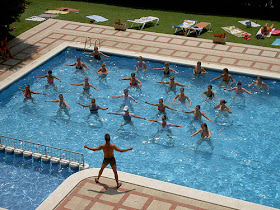Today's post is for you, who enjoy being in an aqua class. You have already watched your instructor teaching your class either from on the pool deck, from in the pool, or by going back and forth between the deck and pool (these are the three options an instructor has while teaching an aquatic fitness class). Which are the advantages and disadvantages of each teaching position? We'll find out today.
Teaching from the pool deck
This is the preffered method for the Aquatic Exercise Association (AEA) in most situations. AEA recommends that the instructor remain on deck when there is no additional lifeguard on duty, when there are new participants in the program, or when new movements are being demonstrated.
Advantages
- Instructors are highly visible to participants.
- They can use their whole body, upper and lower torso, to provide visual cues.
- Often, but not always, they can be heard better from on deck.
- They have better visibility of their class. They can see what participants are doing. This is especially important if they're expected to be both lifeguard and instructor.
- Some movements, because of their complexity, can only be explained and demonstrated from deck where participants can see what their whole body is doing.
- Complex choreography is better explained and demonstrated from deck.
- New participants can usually follow deck instruction best because the instructor is more visible.
- It is easier to change or adjust their music.
- It is recommended by AEA for most situations.
Disadvantages
- Instructors are exposed to the elements (heat, humidity, sun, wind, chill).
- They increase their risk for injury caused by slipping or impact.
- Theis participants might be in prolonged neck hyperextension looking up at them on deck.
- The tempo and execution of movements (air and gravity) must be altered to approximate water conditions (viscosity and buoyancy).
- It can be difficult to demonstrate water-specific movements from land.
Teaching from within the pool
There may be times when teaching from within the pool is the preffered option. In order to provide the participants with a safe and effective workout, there are several considerations that must be made by the class leader and, just as with deck instruction, it requires practice to develop good instructor skills.
Advantages
- Instructors are no exposed to the elements and have the benefit of the cooling effect of the water.
- They benefit from the cushioning effect of the water and reduced impact stress.
- They can circulate around their class giving one-on-one feedback and contact. They can use touch training when appropriate.
- They can feel the movement in the same way as the participants. This may enable them to better motivate and also allows them to more precisely adjust intensity for some movements.
- It is easier to demonstrate with proper tempo and weight transfer from in the water.
- It allows them to connect with their class.
Disadvantages
- It is very difficult for participants to see what the instructor is doing. If they have a large class or several new participants, teaching from in the pool can be very challenging.
- They are virtually eliminating visual cueing with the lower torso. Because most participants are visual learners, some might get frustrated when they cannot see what they are supposed to do.
- It might be more difficult for participants to hear or understand the instructor.
- Some movements are impossible to explain or demonstrate from in the pool, such as complicated leg pattern involving turns.
- From a safety standpoint, they want to teach from on the deck if there is no lifeguard available so they can easily recognize a water rescue situation.
Teaching from on deck and in the pool
This method combines the advantages of on-deck and in-pool teaching and reduces the disadvantages. Of course there are safety concerns for an instructor who frequently goes back and forth from the pool to deck. A great solution, for the instructors, is to teach the first half of the class from the deck to familiarize participants with all the moves. Then they can get into the pool for the second half of the class ad use those moves to create combinations, patterns, and add travel.
Teaching from the deck requires a different set of skills from teaching in the water. Instructors need to learn tempo, movement execution, and weight transfer from deck as well as cueing and choreography techniques for instructing in the water. The extra effort pays off when they learn as many teaching styles and techniques as possible. This puts them in the best position to teach any particulat segment of their class and expand their choreography and programming options.


No comments:
Post a Comment